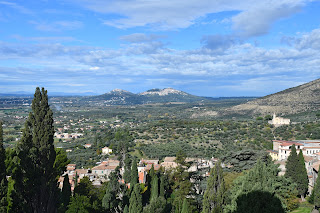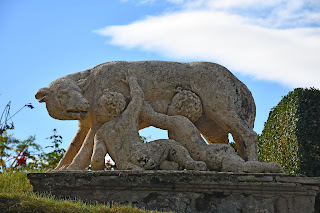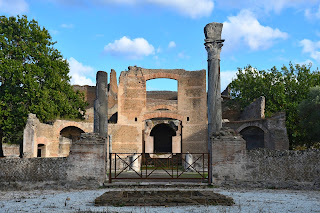Italy from South to North – Day 5: Tivoli
Today was a less manic day than the standard for this trip. We packed all our bags and headed to the train station, where Aron had previously noticed a bag depository. We left his large camping bag there so that he would not have to lug it around all day, and we stuffed my plastic bags full of dirty and clean clothes inside it. My choice of breakfast foods was nonstandard: having noticed a few novelty gelato flavours, I decided to try out a scoop of mungo pine and another scoop of Sorrento lemon. The first genuinely tasted like pine needles (I don’t know what else I was expecting), while the second was very flavourful. Aron and I also tried martozzi, a kind of sliced bun brimming with cream.
Having bought tickets
for the 9:05 train to Tivoli, we expected to reach our destination by around
10. The train, however, kept gathering so many delays that we came about half
an hour later than expected. Still, the town seemed relatively empty of tourists,
especially in comparison with the madness we had witnessed in Rome.
We began our tour of
Tivoli by crossing the Gregorian Bridge into the old town. From this vantage
point, we could easily see the ancient Temple of Vesta and the Temple of the
Sybil standing on an escarpment above the stream. The Temple of Vesta is the more
visually prominent of the two, standing closer to the bridge and boasting several
well-preserved columns on a circular base. The Temple of the Sybil, however,
has a more interesting backstory: it is said that the emperor Augustus once
visited the Tiburtine Sybil to ask whether he should let himself be worshipped
as a god. According to the story, the Sybil responded that one day a much
greater man would be born, and he would be the saviour of the world.
Having crossed the bridge
to the old town, we bought combined tickets for the Villa d’Este and Hadrian’s
Villa, which are among the most famous villas in Tivoli. The Villa d’Este was
constructed by Cardinal Ippolito II d’Este, who was one of the richest
clergymen of his time and a great patron of the arts. D’Este ran for Pope five
times, but his lavish lifestyle undermined his candidacy at a time when the
Catholic clergy was coming under increasing criticism for its extravagance. In
return for supporting one of his competitors, the cardinal was awarded the
governorship of Tivoli, allowing him to construct his luxurious mansion.
The Villa d’Este was
something of a marvel when it was first built thanks to its gardens. Boasting
fountains of all shapes and sizes, it impressed visitors with both visual
splendour and clever auditory tricks. Some of the fountains reached imposing
heights, while other water features – like a long wall lined with three layers
of spouts – reached impressive numbers. Aron and I spent a fair amount of time
walking around the gardens, where I furtively plucked a tiny tangerine and
discovered that despite its zesty rind, it was as sour as a lime.
Uncertain of how to
reach Hadrian’s Villa, which according to Google Maps lay about an hour away by
foot, we asked for help at the ticket office. We were told there was a bus stop
by the nearby plaza, and that we could buy the tickets at a nearby café. We had
no trouble finding the bus stop: it was flocked by a throng of people, whom
Aron astutely identified as local since they were all smoking. As soon as we
figured out the schedule on the nearby notice board, however, the bus came
hurtling down the street, and we jumped on for fear that it might take another
half an hour for the next bus to show up.
Standing by the
driver, we attempted to buy our tickets from her, but the language barrier
proved very tall indeed. From the snippets I picked up, the driver was telling
us we should buy our tickets from the café. When we tried to make her
understand that this advice was no longer very relevant, she offered to sell us
tickets for cash. From what we gathered, she wanted fourteen euros, but between
the two of us we could only procure a 10 and a 20-euro banknote. Clearly behind
schedule, the driver gave up and let us stay on board.
Very helpfully, the
driver and another passenger let us know when we reached the closest bus stop
to Hadrian’s Villa. It took another twenty minutes by foot to reach the
entrance of the complex. The contrast between this and the Villa d’Este was
huge. With few cars in the parking lot and no one monitoring the turnstiles,
the villa was practically empty. A good millennium and a half older than the
Villa d’Este, it was mostly in ruins, though we did see a few impressive
structures and some beautiful statues reflected in its pools. Only thanks to
the 3d miniature in one of the houses did we glean something of the glamour and
sheer size of this erewhile imperial pleasure ground.
Getting back to Tivoli
from Villa d’Este was much simpler than getting there. At the ticket office, we
were told that the bus would arrive at the bus stop imminently, and we were
left in no doubt as to where the bus stop was. Italian ideas about time are
rather stretchy, so we ended up waiting another fifteen minutes, but the bus did
arrive. This time, it was clearly the correct shuttle running between the two
villas; the bus driver even spoke English and accepted cash. We arrived in
Tivoli with just enough time to take a few pictures of the fortress Rocca Pia,
after which we hurried to the train station and took the train back to Rome.
Having eaten no lunch,
we stuffed ourselves at the station. Aron and I shared an arancine and ate one
panzerotto each, after which Aron ate some Sicilian desserts and I had a
gianduiotto gelato. We agreed that the panzerotto is not our favourite snack:
like a calzone closed on all sides, it has a high ratio of dough to filling and
is not fried like a battilocchio.
We departed after
seven and arrived in Florence at half past nine. The walk to our hotel took us
past the stunning cathedral, which in the night seemed like an otherworldly
apparition. Its stripes gave the building an almost two-dimensional,
cartoonlike quality, while the size of the dome – visible from both near and
far – impressed upon us the fact that this was the largest cupola built in over
a thousand years since the erection of the Pantheon and the Hagia Sophia.










































Comments
Post a Comment